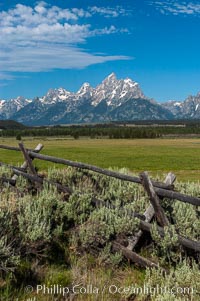
Teton Range, Grand Teton National Park.
Location: Grand Teton National Park, Wyoming
Image ID: 07433
Location: Grand Teton National Park, Wyoming
Image ID: 07433
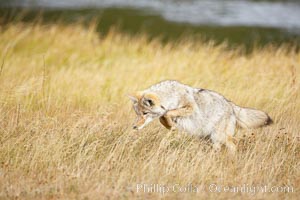
A coyote hunts for voles in tall grass, autumn.
Species: Coyote, Canis latrans
Location: Yellowstone National Park, Wyoming
Image ID: 19638
Species: Coyote, Canis latrans
Location: Yellowstone National Park, Wyoming
Image ID: 19638
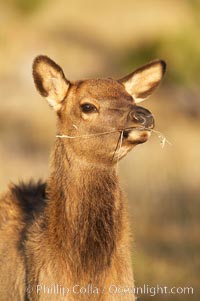
Juvenile elk in golden, late afternoon light, in meadow along Madison River, autumn.
Species: Elk, Cervus canadensis
Location: Yellowstone National Park, Wyoming
Image ID: 19709
Species: Elk, Cervus canadensis
Location: Yellowstone National Park, Wyoming
Image ID: 19709
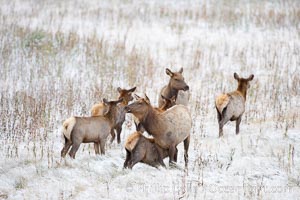
Female and young elk in early autumn snowfall.
Species: Elk, Cervus canadensis
Location: Yellowstone National Park, Wyoming
Image ID: 19713
Species: Elk, Cervus canadensis
Location: Yellowstone National Park, Wyoming
Image ID: 19713
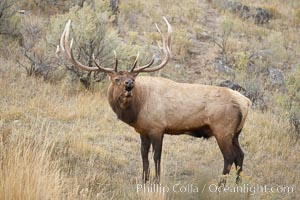
Male elk bugling during the fall rut. Large male elk are known as bulls. Male elk have large antlers which are shed each year. Male elk engage in competitive mating behaviors during the rut, including posturing, antler wrestling and bugling, a loud series of screams which is intended to establish dominance over other males and attract females.
Species: Elk, Cervus canadensis
Location: Mammoth Hot Springs, Yellowstone National Park, Wyoming
Image ID: 19715
Species: Elk, Cervus canadensis
Location: Mammoth Hot Springs, Yellowstone National Park, Wyoming
Image ID: 19715
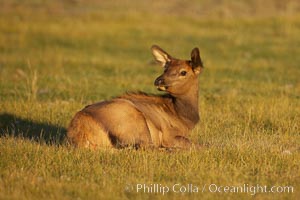
Juvenile elk in golden, late afternoon light, in meadow along Madison River, autumn.
Species: Elk, Cervus canadensis
Location: Yellowstone National Park, Wyoming
Image ID: 19717
Species: Elk, Cervus canadensis
Location: Yellowstone National Park, Wyoming
Image ID: 19717
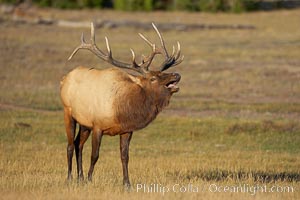
Male elk bugling during the fall rut. Large male elk are known as bulls. Male elk have large antlers which are shed each year. Male elk engage in competitive mating behaviors during the rut, including posturing, antler wrestling and bugling, a loud series of screams which is intended to establish dominance over other males and attract females.
Species: Elk, Cervus canadensis
Location: Yellowstone National Park, Wyoming
Image ID: 19719
Species: Elk, Cervus canadensis
Location: Yellowstone National Park, Wyoming
Image ID: 19719
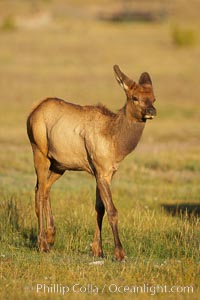
Juvenile elk in golden, late afternoon light, in meadow along Madison River, autumn.
Species: Elk, Cervus canadensis
Location: Yellowstone National Park, Wyoming
Image ID: 19720
Species: Elk, Cervus canadensis
Location: Yellowstone National Park, Wyoming
Image ID: 19720
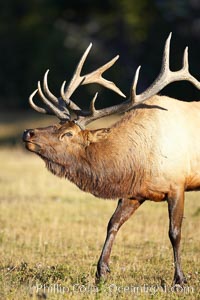
Elk, bull elk, adult male elk with large set of antlers. By September, this bull elk's antlers have reached their full size and the velvet has fallen off. This bull elk has sparred with other bulls for access to herds of females in estrous and ready to mate.
Species: Elk, Cervus canadensis
Location: Yellowstone National Park, Wyoming
Image ID: 19722
Species: Elk, Cervus canadensis
Location: Yellowstone National Park, Wyoming
Image ID: 19722
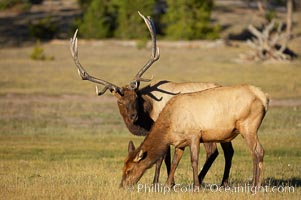
Male elk (bull) alongside female elk in grassy meadow, during rutting season. A bull will defend his harem of 20 cows or more from competing bulls and predators. Only mature bulls have large harems and breeding success peaks at about eight years of age. Bulls between two to four years and over 11 years of age rarely have harems, and spend most of the rut on the periphery of larger harems. Young and old bulls that do acquire a harem hold it later in the breeding season than do bulls in their prime. A bull with a harem rarely feeds and he may lose up to 20 percent of his body weight while he is guarding the harem.
Species: Elk, Cervus canadensis
Location: Yellowstone National Park, Wyoming
Image ID: 19723
Species: Elk, Cervus canadensis
Location: Yellowstone National Park, Wyoming
Image ID: 19723
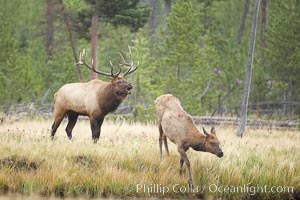
Bull elk, with large antlers, alongside female elk during rutting season, autumn. A bull will defend his harem of 20 cows or more from competing bulls and predators. Only mature bulls have large harems and breeding success peaks at about eight years of age. Bulls between two to four years and over 11 years of age rarely have harems, and spend most of the rut on the periphery of larger harems. Young and old bulls that do acquire a harem hold it later in the breeding season than do bulls in their prime. A bull with a harem rarely feeds and he may lose up to 20 percent of his body weight while he is guarding the harem.
Species: Elk, Cervus canadensis
Location: Yellowstone National Park, Wyoming
Image ID: 19724
Species: Elk, Cervus canadensis
Location: Yellowstone National Park, Wyoming
Image ID: 19724
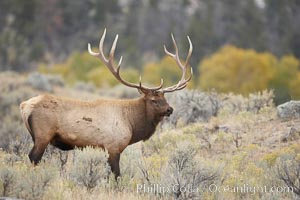
Bull elk in sage brush with large rack of antlers during the fall rut (mating season). This bull elk has sparred with other bulls to establish his harem of females with which he hopes to mate.
Species: Elk, Cervus canadensis
Location: Mammoth Hot Springs, Yellowstone National Park, Wyoming
Image ID: 19746
Species: Elk, Cervus canadensis
Location: Mammoth Hot Springs, Yellowstone National Park, Wyoming
Image ID: 19746
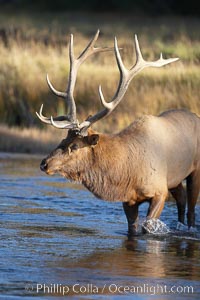
Male elk bugling during the fall rut. Large male elk are known as bulls. Male elk have large antlers which are shed each year. Male elk engage in competitive mating behaviors during the rut, including posturing, antler wrestling and bugling, a loud series of screams which is intended to establish dominance over other males and attract females.
Species: Elk, Cervus canadensis
Location: Madison River, Yellowstone National Park, Wyoming
Image ID: 19781
Species: Elk, Cervus canadensis
Location: Madison River, Yellowstone National Park, Wyoming
Image ID: 19781
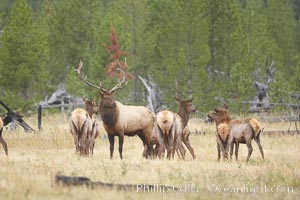
Bull elk, with large antlers, alongside female elk during rutting season, autumn. A bull will defend his harem of 20 cows or more from competing bulls and predators. Only mature bulls have large harems and breeding success peaks at about eight years of age. Bulls between two to four years and over 11 years of age rarely have harems, and spend most of the rut on the periphery of larger harems. Young and old bulls that do acquire a harem hold it later in the breeding season than do bulls in their prime. A bull with a harem rarely feeds and he may lose up to 20 percent of his body weight while he is guarding the harem.
Species: Elk, Cervus canadensis
Location: Yellowstone National Park, Wyoming
Image ID: 19782
Species: Elk, Cervus canadensis
Location: Yellowstone National Park, Wyoming
Image ID: 19782
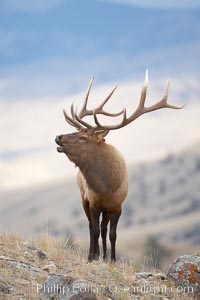
Male elk bugling during the fall rut. Large male elk are known as bulls. Male elk have large antlers which are shed each year. Male elk engage in competitive mating behaviors during the rut, including posturing, antler wrestling and bugling, a loud series of screams which is intended to establish dominance over other males and attract females.
Species: Elk, Cervus canadensis
Location: Mammoth Hot Springs, Yellowstone National Park, Wyoming
Image ID: 19788
Species: Elk, Cervus canadensis
Location: Mammoth Hot Springs, Yellowstone National Park, Wyoming
Image ID: 19788
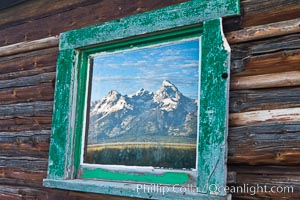
Teton Range reflection, in window of old barn in Grand Teton National Park.
Location: Grand Teton National Park, Wyoming
Image ID: 26915
Location: Grand Teton National Park, Wyoming
Image ID: 26915
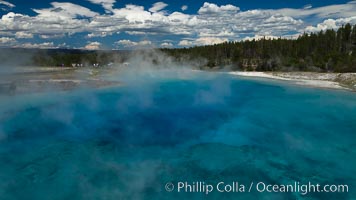
Excelsior Geyser, now dormant, was formerly the worlds largest geyser. It still produces immense runoff into the Firehole River: 4,500 gallons per minute, or 6 million gallons per day. It is located in Midway Geyser Basin.
Location: Midway Geyser Basin, Yellowstone National Park, Wyoming
Image ID: 26953
Location: Midway Geyser Basin, Yellowstone National Park, Wyoming
Image ID: 26953
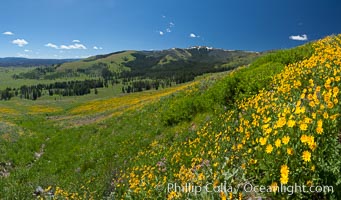
Wildflowers on Mount Washburn, on the north side of Dunraven Pass near Tower Junction.
Species: Little sunflower, One-eyed sunflower, Helianthella uniflora
Location: Yellowstone National Park, Wyoming
Image ID: 26960
Panorama dimensions: 5154 x 8796
Species: Little sunflower, One-eyed sunflower, Helianthella uniflora
Location: Yellowstone National Park, Wyoming
Image ID: 26960
Panorama dimensions: 5154 x 8796
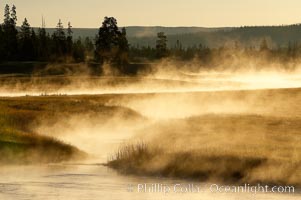
Madison River steaming in the cold air, sunrise, autumn, tall grasses and golden light.
Location: Madison River, Yellowstone National Park, Wyoming
Image ID: 19592
Location: Madison River, Yellowstone National Park, Wyoming
Image ID: 19592
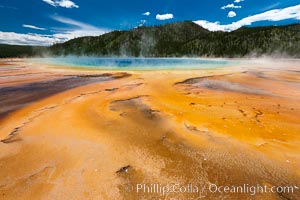
Bacteria mats and Grand Prismatic Spring. The orange color is due to bacteria which thrive only on the cooler fringes of the hot spring, while the hotter center of the spring hosts blue-colored bacteria.
Location: Midway Geyser Basin, Yellowstone National Park, Wyoming
Image ID: 26954
Location: Midway Geyser Basin, Yellowstone National Park, Wyoming
Image ID: 26954
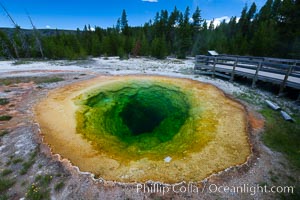
Morning Glory Pool, has long been considered a must-see site in Yellowstone. At one time a road brought visitors to its brink. Over the years they threw coins, bottles and trash in the pool, reducing its flow and causing the red and orange bacteria to creep in from its edge, replacing the blue bacteria that thrive in the hotter water at the center of the pool. The pool is now accessed only by a foot path.
Location: Upper Geyser Basin, Yellowstone National Park, Wyoming
Image ID: 26955
Location: Upper Geyser Basin, Yellowstone National Park, Wyoming
Image ID: 26955
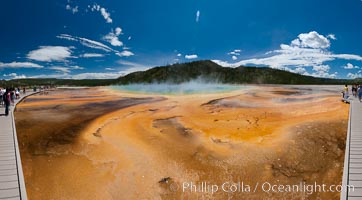
Bacteria mats and Grand Prismatic Spring. The orange color is due to bacteria which thrive only on the cooler fringes of the hot spring, while the hotter center of the spring hosts blue-colored bacteria.
Location: Midway Geyser Basin, Yellowstone National Park, Wyoming
Image ID: 26958
Panorama dimensions: 4624 x 8376
Location: Midway Geyser Basin, Yellowstone National Park, Wyoming
Image ID: 26958
Panorama dimensions: 4624 x 8376
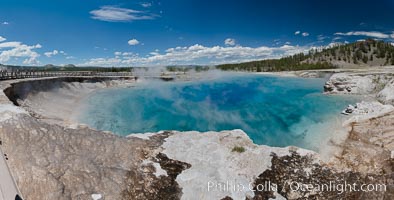
Panorama of Excelsior Geyser, now dormant, was formerly the worlds largest geyser. It still produces immense runoff into the Firehole River: 4,500 gallons per minute, or 6 million gallons per day. It is located in Midway Geyser Basin.
Location: Midway Geyser Basin, Yellowstone National Park, Wyoming
Image ID: 26959
Panorama dimensions: 5188 x 10216
Location: Midway Geyser Basin, Yellowstone National Park, Wyoming
Image ID: 26959
Panorama dimensions: 5188 x 10216
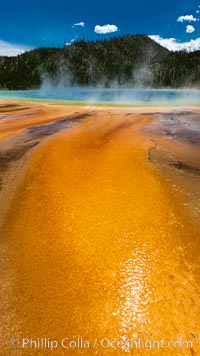
Bacteria mats and Grand Prismatic Spring. The orange color is due to bacteria which thrive only on the cooler fringes of the hot spring, while the hotter center of the spring hosts blue-colored bacteria.
Location: Midway Geyser Basin, Yellowstone National Park, Wyoming
Image ID: 26964
Location: Midway Geyser Basin, Yellowstone National Park, Wyoming
Image ID: 26964
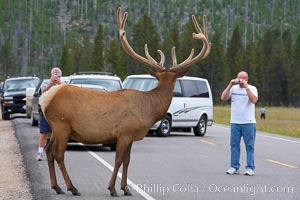
Tourists get a good look at wild elk who have become somewhat habituated to human presence in Yellowstone National Park.
Species: Elk, Cervus canadensis
Location: Yellowstone National Park, Wyoming
Image ID: 13161
Species: Elk, Cervus canadensis
Location: Yellowstone National Park, Wyoming
Image ID: 13161
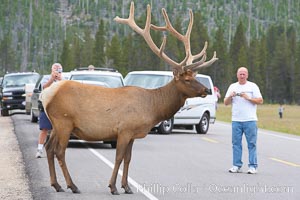
Tourists get a good look at wild elk who have become habituated to human presence in Yellowstone National Park.
Species: Elk, Cervus canadensis
Location: Yellowstone National Park, Wyoming
Image ID: 13192
Species: Elk, Cervus canadensis
Location: Yellowstone National Park, Wyoming
Image ID: 13192
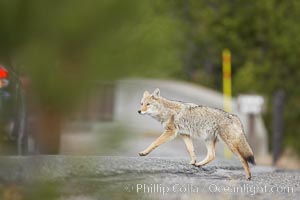
Coyote crosses a road in front of a car. Dozens of coyotes, wolves, bears, elk and bison are killed each year in Yellowstone as they attempt to cross the roads in front of drivers who are not paying attention or speeding.
Species: Coyote, Canis latrans
Location: Yellowstone National Park, Wyoming
Image ID: 19649
Species: Coyote, Canis latrans
Location: Yellowstone National Park, Wyoming
Image ID: 19649
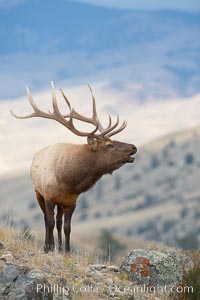
Male elk bugling during the fall rut. Large male elk are known as bulls. Male elk have large antlers which are shed each year. Male elk engage in competitive mating behaviors during the rut, including posturing, antler wrestling and bugling, a loud series of screams which is intended to establish dominance over other males and attract females.
Species: Elk, Cervus canadensis
Location: Mammoth Hot Springs, Yellowstone National Park, Wyoming
Image ID: 19694
Species: Elk, Cervus canadensis
Location: Mammoth Hot Springs, Yellowstone National Park, Wyoming
Image ID: 19694
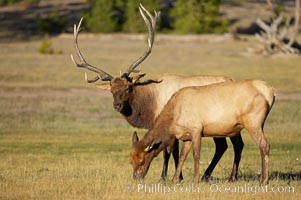
Bull elk, with large antlers, alongside female elk during rutting season, autumn. A bull will defend his harem of 20 cows or more from competing bulls and predators. Only mature bulls have large harems and breeding success peaks at about eight years of age. Bulls between two to four years and over 11 years of age rarely have harems, and spend most of the rut on the periphery of larger harems. Young and old bulls that do acquire a harem hold it later in the breeding season than do bulls in their prime. A bull with a harem rarely feeds and he may lose up to 20 percent of his body weight while he is guarding the harem.
Species: Elk, Cervus canadensis
Location: Yellowstone National Park, Wyoming
Image ID: 19696
Species: Elk, Cervus canadensis
Location: Yellowstone National Park, Wyoming
Image ID: 19696
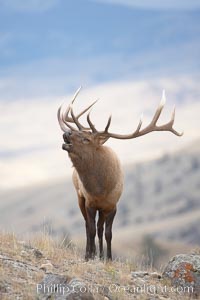
Male elk bugling during the fall rut. Large male elk are known as bulls. Male elk have large antlers which are shed each year. Male elk engage in competitive mating behaviors during the rut, including posturing, antler wrestling and bugling, a loud series of screams which is intended to establish dominance over other males and attract females.
Species: Elk, Cervus canadensis
Location: Mammoth Hot Springs, Yellowstone National Park, Wyoming
Image ID: 19705
Species: Elk, Cervus canadensis
Location: Mammoth Hot Springs, Yellowstone National Park, Wyoming
Image ID: 19705